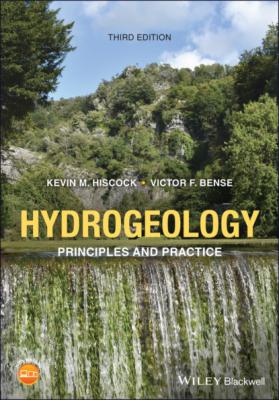ТОП просматриваемых книг сайта:
Hydrogeology. Kevin M. Hiscock
Читать онлайн.Название Hydrogeology
Год выпуска 0
isbn 9781119569510
Автор произведения Kevin M. Hiscock
Жанр Биология
Издательство John Wiley & Sons Limited
Box 1.5 Groundwater Development of the Quaternary Aquifer of the North China Plain
The Quaternary Aquifer of the North China Plain represents one of the world's largest aquifer systems and underlies extensive tracts of the Hai River Basin and the catchments of the adjacent Huai and Huang (Yellow) River Systems (Fig. 1.13) and beyond. This densely populated area comprises a number of extensive plains, known collectively as the North China Plain, and includes three distinct hydrogeological settings within the Quaternary aquifer system (Fig. 1.14). The semi‐arid climate of north‐eastern China is characterized by cold, dry winters (December–March) and hot, humid summers (July–September).
The Quaternary Aquifer supports an enormous exploitation of groundwater which has led to large socio‐economic benefits in terms of irrigated grain production, farming employment and rural poverty alleviation, together with urban and industrial water supply provision. An estimated water supply of 27 × 109 m3 a−1 in the Hai River Basin alone was derived from wells and boreholes in 1988 (MWR 1992), but such large exploitation of groundwater has led to increasing difficulties in the last few years.
Given the heavy dependence on groundwater resources in the North China Plain, a number of concerns have been identified in recent years (Fig. 1.13) including a falling water table in the shallow freshwater aquifer, declining water levels in the deep freshwater aquifer, aquifer salinization as a result of inadequately controlled pumping and aquifer pollution from uncontrolled urban and industrial wastewater discharges. These issues are interlinked, but do not affect the three main hydrogeological settings equally (Table 1.7). A range of water resources management strategies are considered by Foster et al. (2004) that could contribute to reducing and eventually eliminating the current aquifer depletion and include agricultural water‐saving measures, changes in land use and crop regimes, artificial aquifer recharge of excess surface runoff, re‐use of treated urban wastewater, and improved institutional arrangements that deliver these water savings and technologies while at the same time limiting further exploitation of groundwater for irrigated agriculture and industrial production (Foster et al. 2004).
Fig. 1.13 Location map of the North China Plain showing the distribution of areas exhibiting marked groundwater depletion as a consequence of aquifer over‐exploitation of the Quaternary aquifer system (Fig. 1.14) (Foster et al. 2004).
(Source: Foster, S., Garduno, H., Evans, R. et al. (2004) Quaternary Aquifer of the North China Plain – assessing and achieving groundwater resource sustainability. Hydrogeology Journal 12, 81–93. © 2004, Springer Nature.)
Fig. 1.14 Cross‐section of the North China Plain showing the general hydrogeological setting of the Quaternary aquifer system which includes the gently sloping piedmont plain and associated major alluvial fans, the main alluvial plain (Heilongang) and the coastal plain around the margin of the Bohai Sea (Foster et al. 2004).
(Source: Foster, S., Garduno, H., Evans, R. et al. (2004) Quaternary Aquifer of the North China Plain – assessing and achieving groundwater resource sustainability. Hydrogeology Journal 12, 81–93. © 2004, Springer Nature.)
Table 1.7 Key groundwater issues in the North China Plain listed according to hydrogeological setting (Fig. 1.14) (Foster et al. 2004).
(Source: Foster, S., Garduno, H., Evans, R. et al. (2004) Quaternary Aquifer of the North China Plain – assessing and achieving groundwater resource sustainability. Hydrogeology Journal 12, 81–93. © 2004, Springer Nature.)
| Groundwater issue | Hydrogeological setting | ||
|---|---|---|---|
| Piedmont plain | Flood plain | Coastal plain | |
| Falling water table of shallow freshwater aquifer | +++a | +++ | + |
| Depletion of deep freshwater aquifer | 0b | +++ | ++ |
| Risk of shallow aquifer and/or soil salinization | 0 | ++ | +++ |
| Groundwater pollution from urban and industrial wastewater | +++ | + | 0 |
Notes:
a +++, very important; ++, important; +, minor importance; 0, not important.
b Effects of excessive abstraction may be reflected in the overlying shallow freshwater aquifer which is here in hydraulic continuity.
1.8 Groundwater resources in developing countries
It remains one of the greatest challenges for the future to provide the basic amenity of a safe and reliable supply of drinking water to the entire world’s population. Despite the efforts of governments, charities and aid agencies, many villagers have to walk hundreds of metres to obtain drinking water from sources that may be unprotected from contamination (Fig. 1.15). Pollution sources include unsewered pit latrines to dispose of human wastes, inorganic fertilizers and pesticides used in an effort to secure self‐sufficiency in food production and industrial wastes in urban areas.
In the developing world, groundwater is

